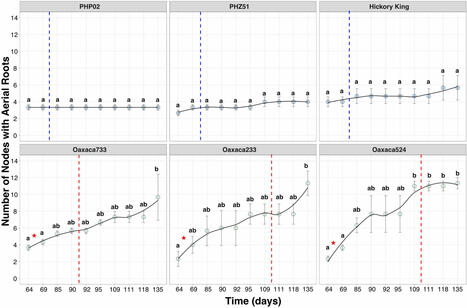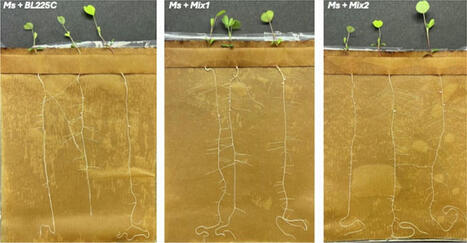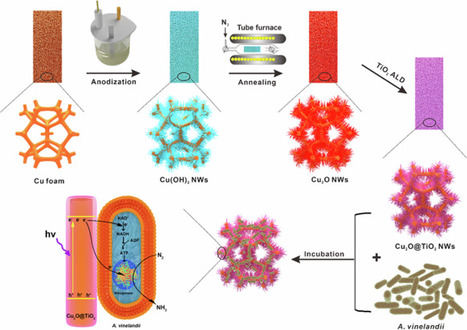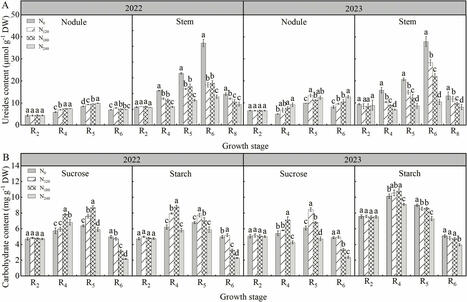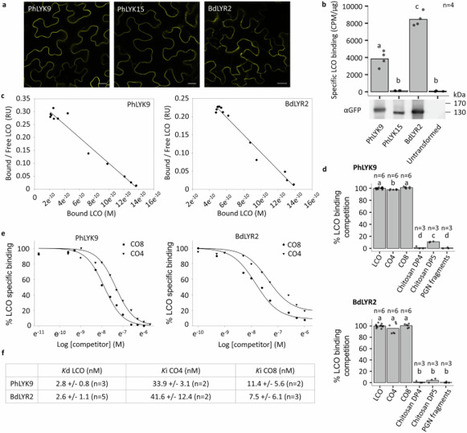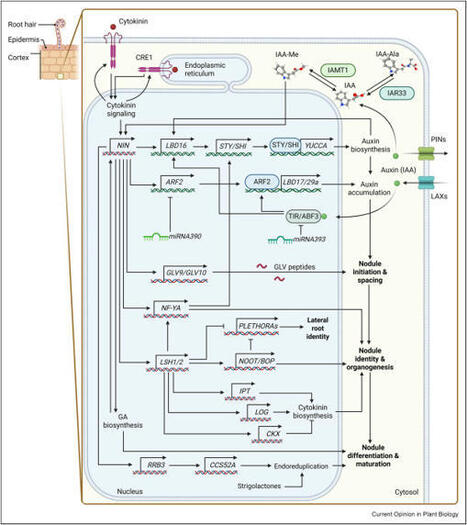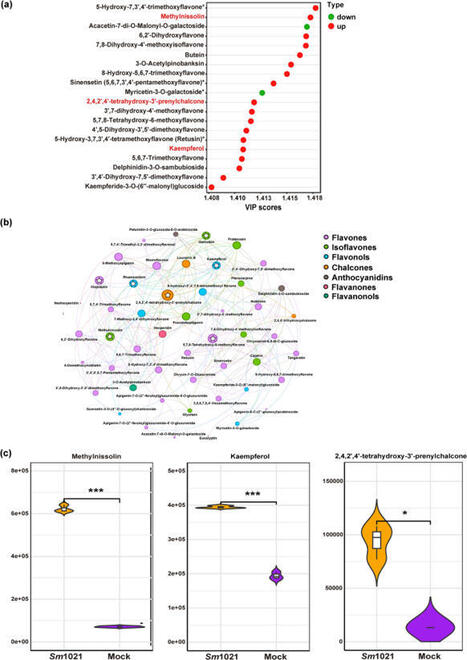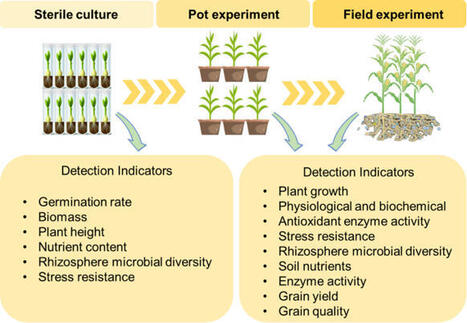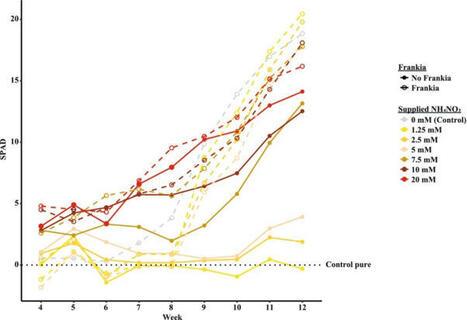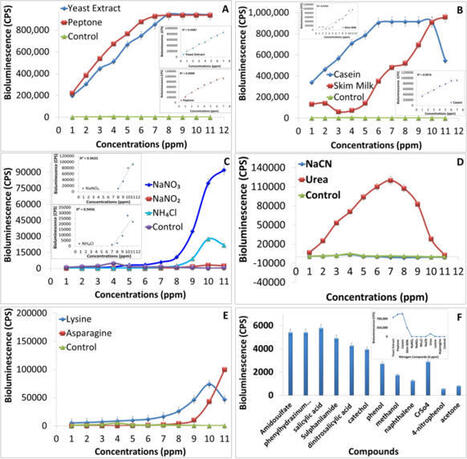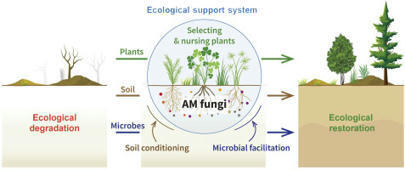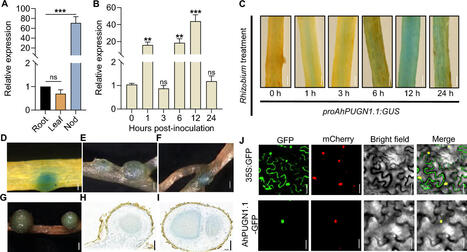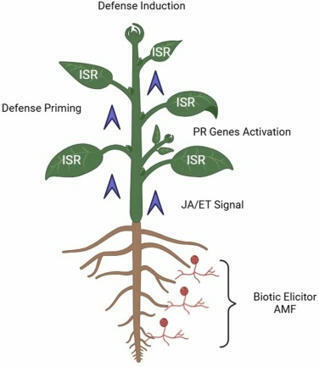 Your new post is loading...
 Your new post is loading...

|
Scooped by
Jean-Michel Ané
July 15, 3:29 PM
|
Arbuscular mycorrhizal fungi (AMF) are crucial components of the soil microbiomes that establish symbiotic associations with most terrestrial plants. The review summarizes the basic mechanisms behind the plant-AMF symbiosis, the genes involved in the fungal and their plant counterparts, novel biomolecules and growth regulators, leading to probable signal transduction pathways. It also focuses on the involvement of lipids and strigolactones in establishing AMF-plant symbiosis. Herein, we further emphasize the role played by these AMF in enhancing plant resistance to various abiotic stresses while giving a broad outline of current research practices and attempting to dissect the mechanism behind the AMF-mediated abiotic stress signal transduction. Discussion on the mechanisms behind this stress reduction involving AMF will be valuable for the researchers, agronomists, and environmentalists involved in sustainable agriculture. Water scarcity, salinity, heavy metals, and extreme temperatures are the primary abiotic stresses that pose serious challenges to agricultural sustainability and ecosystem functioning. Conventional responses to such pressures typically rely on genetic modifications as well as chemical treatments, which could be expensive and detrimental to the environment. However, these AM fungi act in an alternative way that is natural and cost-effective too, leading to healthy plants with resilience toward stress through symbiosis, leading to the fulfillment of the United Nations Sustainable Development Goal (UNSDG) 2 of zero hunger.

|
Scooped by
Jean-Michel Ané
July 15, 3:24 PM
|
Plants and animals house microbes that provide critical nutrients, but little is known about host control over microbial cooperation when resources are also accessed from the environment. Changes in nutrient access can challenge the host’s ability to detect and selectively reward beneficial partners, destabilizing symbiosis. Legumes acquire nitrogen from soil and from symbiosis with rhizobia, but it is unclear if extrinsic sources of nitrogen interfere with host control systems. We inoculated the legume Lotus japonicus with rhizobia-bearing nitrogen fixation or nitrogen metabolism knockouts, and factorially varied molecular sources of nitrogen fertilizer. Lotus hosts selectively rewarded beneficial rhizobia and sanctioned non-fixing strains when extrinsic nitrogen was unavailable. Host benefits were undiminished when inoculated with rhizobia-bearing nitrogen metabolism knockouts, suggesting redundancies in nitrogen provisioning systems. However, under nitrogen fertilization, hosts did not discriminate between fixing and non-fixing rhizobia. Fertilized hosts formed miniaturized nodules housing limited rhizobia, divesting from symbiosis. Thus, sanctioning mechanisms rely on the detection of nitrogen fixation differences among rhizobia strains and can break down in nitrogen-rich environments. Nonetheless, divestment from symbiosis offers legumes robust host control, minimizing investment into rhizobia strains, irrespective of their capacity to provide benefit, when symbiosis services are not needed.

|
Scooped by
Jean-Michel Ané
July 15, 3:06 PM
|
Endomycorrhizas are symbiotic associations between plant roots and fungi that play a crucial role in plant nutrition and ecosystem functioning. This review explores conserved and divergent strategies underlying fungal accommodation in arbuscular (AM), ericoid (ERM), and orchid (ORM) mycorrhizas. One feature common to all three symbioses is the formation of an interface compartment that mediates nutrient exchange, a trait first observed in AM and later confirmed in ERM and ORM. In this process, the host cell organization undergoes significant modifications, including vacuolar fragmentation, nuclear repositioning and cytoskeletal rearrangement. While transcriptomic and genomic analyses confirm the conservation of several features, such as the upregulation of plant and fungal membrane transporters, substantial differences emerge in fungal hydrolytic enzyme activity and nutrient acquisition strategies. The evolutionary history of these associations suggests that AM fungi were the ancestral symbionts of land plants, with ERM and ORM fungi replacing them in specific ecological niches. Advances in single-nucleus transcriptomics and nuclear dynamics studies are providing new insights into the mechanisms governing these complex symbioses. Understanding the balance between conservation and divergence in endomycorrhizal interactions is critical for unravelling their functional significance in plant-fungal co-evolution.

|
Scooped by
Jean-Michel Ané
July 14, 4:35 PM
|
Soil microbial-metabolite interactions influence crop productivity, yet their responses to long-term nutrient management in legume systems warrant further investigation. This study examined how fertilization and Rhizobium inoculation reshape soybean rhizosphere fungal-metabolite networks to improve soil health. Through a decade-long field trial utilizing Internal Transcribed Spacer (ITS) sequencing and Liquid Chromatography-Mass Spectrometry (LC-MS) metabolomics, four treatments were evaluated: control (CK), phosphorus-potassium fertilization (PK), PK with nitrogen fertilization (PK+N), and PK with Bradyrhizobiumjaponicum 5821 inoculation (PK+R). Results indicated that nitrogen fertilization increased fungal diversity at maturity and enhanced co-occurrence network complexity (displaying the highest node and edge counts), while Bradyrhizobium inoculation promoted stochastic assembly. Soil fungi exhibited notable correlations with 3-Hydroxymethylantipyrine, Chrysophanol, 3,7-Dihydroxyflavone and Triethylamine. Metabolite profiling revealed nitrogen suppression of stress-resistance flavonoids (3-Hydroxymethylantipyrine, Chrysophanol, 3,7-Dihydroxyflavone), whereas Bradyrhizobium enhanced these key metabolites. KEGG enrichment identified tryptophan and caffeine metabolism as central during flowering-podding, coordinating nitrogen assimilation and defense responses. Additionally, the key metabolites correlated significantly with soil total nitrogen, organic matter, and available nitrogen. These findings reveal that Bradyrhizobium acts synergistically with fertilization to activate fungal-driven metabolic pathways, offering a microbiome-based approach to enhance nitrogen efficiency and reduce agrochemical dependency in soybean systems.

|
Scooped by
Jean-Michel Ané
July 14, 4:30 PM
|
The ever-increasing human population necessitates an urgent demand for ensuring food sovereignty through sustainable agriculture practices. Cyanobacteria, resilient photosynthetic microorganisms throughout the course of evolution, are found either freely or in symbiotic associations with a diverse range of lower and higher plants. Cyanobacteria-plants interactions are beneficial associations for both cyanobionts and crops. These symbiotic interactions benefit crop plants by producing valuable bioactive compounds to promote their growth and induce abiotic and biotic stress resistance. In this chapter, the first section pinpoints the genetically modified (GM) cyanobacteria and their potential in sustainable agriculture; it discusses the genetic engineering techniques employed in cyanobacteria and highlights some successful case studies showcasing the efficacy of GM cyanobacteria in agricultural settings. Then, cyanobacteria-plants interactions are explored, focusing on the intricate processes occurring in the rhizosphere. Finally, the associations of agricultural crops with different cyanobacterial strains are discussed. The lifestyle and ecological niches of cyanobacteria are also highlighted with an emphasis on their significance in establishing successful symbiotic relationships with crops. In addition, key benefits of cyanobacteria-plants symbiosis are outlined, including enhanced nutrient acquisition, increased plant growth, etc. Overall, we hope to broaden a deeper understanding of these mechanisms and interactions by harnessing the capabilities of cyanobacteria in promoting sustainable agriculture, particularly in developing countries.

|
Scooped by
Jean-Michel Ané
July 11, 11:37 AM
|
Maize (Zea mays L.) is the most widely produced crop in the world, and conventional production requires significant amounts of synthetic nitrogen fertilizer, which has negative economic and environmental consequences. Maize landraces from Oaxaca, Mexico, can acquire nitrogen from nitrogen-fixing bacteria that live in a mucilage secreted by aerial nodal roots. The development of these nodal roots is a characteristic traditionally associated with the juvenile vegetative stage of maize plants. However, mature Oaxacan landraces develop many more nodes with aerial roots than commercial maize varieties. Our study shows that Oaxacan landraces develop aerial roots during the juvenile and adult vegetative phases and even during early flowering under greenhouse and field conditions. Surprisingly, the development of these roots was only minimally affected by soil nitrogen and ambient humidity. These findings are an essential first step in developing maize varieties to reduce fertilizer needs in maize production across different environmental conditions.

|
Scooped by
Jean-Michel Ané
July 7, 9:52 AM
|
El cambio climático global, el aumento de la población y el uso excesivo de productos agroquímicos han dado lugar a diversos problemas, como la degradación del suelo, la caída de la producción de alimentos y cuestiones medioambientales que han arrinconado al sector agrícola. Para superarlos, los biofertilizantes, en particular los micorrícicos, han surgido como una alternativa sostenible y respetuosa con el medio ambiente. La micorriza arbuscular (MA), una alianza entre las raíces de las plantas y los hongos del subfilo Glomeromycotina, que se encuentra en aproximadamente el 72% de las plantas terrestres, es uno de los tipos de simbiosis más comunes y antiguos de la Tierra. Los hongos MA proporcionan a las plantas multitud de beneficios a cambio de fotoasimilados vegetales. Aunque los hongos MA pueden ser una buena opción biofertilizante, su uso es muy limitado, ya que existen diversos problemas que van desde su producción hasta su aplicación. Esta revisión arroja luz sobre el potencial de los hongos MA como biofertilizantes, analizando sus diversos beneficios y abordando al mismo tiempo las limitaciones asociadas a su producción y aplicación para aumentar la productividad agrícola.

|
Scooped by
Jean-Michel Ané
July 5, 6:40 PM
|
•Rhizobia and non-rhizobial endophytes synergistically enhance alfalfa growth
• Functional redundancy of synthetic microbial communities to predict success in field trials
• Effective endophytic inoculants do not significantly alter the native rhizosphere biodiversity

|
Scooped by
Jean-Michel Ané
July 5, 6:28 PM
|
The integration of microbial nitrogen (N2) fixation with photochemical processes using inorganic light-absorbing nanomaterials is a burgeoning field in sustainable energy production. Here, we explore the synergistic combination of inorganic semiconductor nanowires (NWs) with whole-cell microorganisms to create an inorganic-bacterial biohybrid system. Specifically, we employ Cu2O@TiO2 NWs with a core/shell structure to harness sunlight and generate photoexcited electrons. Azotobacter vinelandii, serving as a biocatalyst, adsorbs onto these NWs and facilitates the reception of photoexcited electrons, thereby enhancing the efficiency of the photoelectrochemical N2 fixation reaction (PEC-NRR). The biohybrid system achieves an impressive ammonia (NH3) yield of (1.49 ± 0.05) × 10-9 mol s-1 cm-2 (5.36 ± 0.18 μmol h-1 cm-2). The enhancement in NH3 synthesis within the Cu2O@TiO2 NWs/A. vinelandii biohybrid is attributed to the increased concentrations of nicotinamide adenine dinucleotide-hydrogen (NADH) and adenosine 5’-triphosphate (ATP), as well as the overexpression of N2-fixing genes like nifH and nifD within the nitrogenase enzyme complex. This study underscores the potential of inorganic-bacterial biohybrid systems in solar-chemical conversion, paving the way for more diverse and functional approaches to harnessing solar energy for sustainable chemical production.

|
Scooped by
Jean-Michel Ané
July 5, 6:23 PM
|
Introduction: Although the mulched drip irrigation system combined with high nitrogen input (240∼310 kg ha-1) in Xinjiang, China, frequently achieves record-high soybean yields (6855 kg ha-1), this practice is not conducive to symbiotic nitrogen fixation and compromises agricultural sustainability.
Methods: Under the mulched drip irrigation, this study evaluation four nitrogen application treatments (N0: 0 kg ha-1, N120: 120 kg ha-1, N180: 180 kg ha-1, and N240: 240 kg ha-1) were evaluated over two consecutive growing seasons to investigate their effects on nodule morphological and physiological traits, stem ureide content, and the percentage of nitrogen derived from the atmosphere (%Ndfa) during the reproductive growth stage.
Results: The application of 180 kg ha-1 nitrogen significantly increased nodule number, nodule dry weight, nodule sucrose content, and nodule starch content, while improving soybean yield and nitrogen agronomic use efficiency. Conversely, the application of nitrogen exceeding 180 kg ha-1 inhibited nitrogenase activity, suppressed leghemoglobin synthesis, disrupted the glutamine synthetase/glutamate synthase metabolic pathway, and reduced ureide translocation from nodules to stems, leading to significant accumulation of ureides in nodules. Correlation and path analyses indicated that nitrogenase activity, leghemoglobin content, urate oxidase activity, and stem ureide content were significantly positively correlated with %Ndfa, whereas nodule ureide content showed a significant negative correlation with %Ndfa. Stem ureide content exhibited a strong direct positive effect on %Ndfa (path coefficient = 0.95), confirming its validity as a robust indicator for assessing SNF capacity.
Discussion: In conclusion, mulched drip irrigation, applying 180 kg ha-1 nitrogen at the beginning pod stage (R3) effectively enhances root nodulation, promotes carbohydrate allocation to nodules, sustains symbiotic nitrogen fixation activity, and ultimately increases soybean yield and nitrogen use efficiency. Thus, under mulched drip irrigation system, applying the correct rate of nitrogen fertilizer is beneficial for enhancing soybean yield and mitigating environmental risks, which holds significant importance for promoting sustainable agricultural development.

|
Scooped by
Jean-Michel Ané
July 5, 6:18 PM
|
Lipo-chitooligosaccharides (LCO) and short-chain chitooligosaccharides (CO) are produced by arbuscular mycorrhizal fungi (AMF) and activate the plant symbiosis signalling pathway, which is essential for mycorrhiza formation. High-affinity LCO receptors belonging to the LysM receptor-like kinase (LysM-RLK) phylogenetic group LYR-IA play a role in AM establishment, but it is unclear which proteins are the plant high-affinity short-chain CO receptors. Here we studied members of the uncharacterized LYR-IB group, and found that they show high affinity for LCO, short- and long-chain CO, and play a complementary role with the LYR-IA receptors for AM establishment. While LYR-IB knock out mutants had a reduced AMF colonization in several species, constitutive/ectopic expression in wheat increased AMF colonization. LYR-IB function is conserved in all tested angiosperms, but in most japonica rice a deletion creates a frameshift in the gene, explaining differences in AM phenotypes between rice and other monocot single LYR-IA mutants. In conclusion, we identified a class of LysM-RLK receptors in angiosperms with unique biochemical properties and a role in both LCO and CO perception for AM establishment.

|
Scooped by
Jean-Michel Ané
July 2, 5:06 PM
|
Plants in the nitrogen-fixing clade have evolved symbiotic root nodules to overcome nitrogen limitations in the soil. These nodules host nitrogen-fixing bacteria that convert atmospheric nitrogen into ammonia, supplying essential nutrients to the plant. Nodule formation is triggered by plant–bacteria interactions and relies on genetic adaptations, including the recruitment of existing regulatory pathways. The transcription factor NODULE INCEPTION (NIN) is a key regulator required for bacterial infection, nodule initiation, and organ differentiation. Nodule development shares key features with lateral root formation, particularly in organ initiation and early growth stages, as both arise from the same root tissue layers. This overlap raises intriguing questions about how nodules evolved distinct forms and functions. This review highlights recent discoveries in the molecular and cellular mechanisms of nodule development, especially in the Papilionoideae clade. By comparing nodules and lateral roots, we explore the regulatory changes that led to their evolutionary divergence. We highlight emerging tools—single-cell and spatial transcriptomics, and advanced imaging—that are deepening insights into nodulation, alongside phylogenomics revealing its evolutionary history.

|
Scooped by
Jean-Michel Ané
June 30, 2:23 PM
|
The soil bacterium Sinorhizobium meliloti can proliferate by leveraging its nitrogen-fixing symbiosis with legumes that form indeterminate root nodules, such as Medicago sativa (alfalfa) and M. truncatula. In contrast to determinate-nodulating legumes, e.g. Glycine max (soybean) and Lotus japonicus, indeterminate-nodulating legumes impose terminal differentiation on nitrogen-fixing (N2-fixing) rhizobia. Thus, the bacterial population is split between those that benefit the plant by N2 fixation, but are a reproductive dead end, and those that are undifferentiated, capable of resuming free-living growth, but not fixing nitrogen. We show that, in mixed nodules colonized by nearly-isogenic strains, with one N2-fixing and one unable to fix N2 (Fix-), alfalfa do not preferentially penalize the Fix- strain, allowing ‘cheating’ at the expense of the plant and the N2-fixer. Thus, a Fix- strain that successfully co-nodulates with a N2-fixing strain can benefit from resources the host provides to the nodule in response to N2 fixed by the co-nodulating strain. Co-invasion of alfalfa nodules with a N2-fixing strain may be a successful strategy for a Fix- strain to cheat both the plant that provides fixed carbon and the N2-fixing strain.
|

|
Scooped by
Jean-Michel Ané
July 15, 3:26 PM
|
Finding methods for the conversion of atmospheric N2 into bioavailable ammonia was one of the great chemistry quests of the early 20th century. This need was fulfilled by the discovery and development of a large-scale method by Haber and Bosch, which produced fertilizer that has supported essential food production since then (1). However, the Haber–Bosch process requires high temperatures and pressures, as well as the reductant H2. In the 21st century, where environmental considerations are more stringent, a new chemistry quest is to accomplish N2 reduction at ambient temperature and pressure, using acids and electron donors (2). Many practitioners are inspired by the nitrogenase enzymes, which perform this feat using unusual iron-sulfur cofactors called FeMoco, FeVco, and FeFeco (Fig. 1, Upper Right shows FeMoco; I refer to the cofactors collectively as FeMco) (3). These slightly differing forms of nitrogenase are expressed by microorganisms depending on the metals available in the environment, but these three very similar enzymes are the only systems in biology known to react with N2. Understanding the structure and mechanism of nitrogenases could hold important clues for teaching chemists how to reduce N2 under similarly mild conditions.

|
Scooped by
Jean-Michel Ané
July 15, 3:11 PM
|
Background and aims
Flavonoids produced by legumes play a crucial role in initiating and regulating nodulation, serving as key signaling molecules in the legume-rhizobium symbiosis. However, the specific roles of individual flavonoids in the symbiotic process of Medicago truncatula remain poorly understood.
Methods
Here, we performed transcriptomic and flavonoid metabolomic analyses of Sinorhizobium meliloti 1021 (Sm1021)-inoculated and mock-inoculated M. truncatula roots at 8 hours post-inoculation (hpi) to investigate the early responses to rhizobial infection.
Results
Our results revealed that flavonoid biosynthesis pathways were significantly enriched in Sm1021-inoculated roots compared to mock-inoculated roots at 8 hpi. Flavonoid metabolome profiling identified 98 differentially accumulated flavonoids between Sm1021-inoculated and mock-inoculated roots at 8 hpi. Three key flavonoids (2,4,2′,4′-tetrahydroxy-3′-prenylchalcone, methylnissolin, and kaempferol) were identified based on high variable importance in projection (VIP) scores and network analysis. Notably, the isoflavone methylnissolin strongly induced the expression of key nodulation genes of Sm1021. Molecular docking analysis indicated that methylnissolin potentially bound to three NodD proteins of Sm1021. Co-inoculation of Sm1021 with methylnissolin promoted nodulation of M. truncatula under nitrogen-limited conditions.
Conclusion
This study provides the first evidence that methylnissolin acts as a crucial inducer of rhizobial nodulation genes, enhancing nitrogen fixation efficiency in M. truncatula. Our findings highlight the pivotal role of flavonoids, particularly isoflavones, in the regulation of the legume-rhizobium symbiotic process.

|
Scooped by
Jean-Michel Ané
July 15, 3:01 PM
|
Plant Growth Promoting Bacteria (PGPB) have been widely shown to improve growth and stress management in plants. Identifying and isolating PGPB are critical steps toward understanding the role of increasing crop yields and growth in complicated ecosystems. However, the techniques available for culturing microorganisms remain limited. Various studies have shown that single microorganisms can exert beneficial effects on plants. Still, it is increasingly evident that when a microbial consortium-two or more interacting microorganisms is involved, additive or synergistic results can be expected. This review article provides an overview of the isolation, cultivation, and application of PGPB. We summarize and discuss the advantages and limitations of novel techniques for screening PGPB, including selective media, high-throughput screening (HTS), and gene editing. The chapter introduces how microbial consortiums are constructed through function combination, machine learning (ML), or artificial intelligence (AI). Compared to conventional techniques, these approaches offer higher precision in selecting compatible and synergistic strains, enabling the development of more stable and efficient PGPB communities. Although promising, such methods are still in the early stages of development and face challenges such as limited datasets, high computational demands, and the complexity of accurately modeling microbe–microbe and microbe–plant interactions. Besides, the discussion concludes with an overview of the commercialization of PGPB, which is expected to facilitate the development of sustainable agriculture.

|
Scooped by
Jean-Michel Ané
July 14, 4:33 PM
|
Background
Symbiotic nitrogen-fixation between bacteria called rhizobia and leguminous plants is a critical aspect of sustainable agriculture. Complex, two-way communication governs the invasion of plant roots and the formation of nodules in which the rhizobia reduce N2 to bioavailable ammonia. Research has uncovered many of the genes required for the symbiosis; however, engineering the symbiosis to function with alternative hosts such as cereal crops necessitates the establishment of a core set of symbiotic players.
Results
We examined the symbiotic relevance of the genes on the 1.68 Mb pSymB chromid of the model rhizobium Sinorhizobium meliloti. By employing a strain in which pSymB was removed, we used a gain-of-function approach to assess a select group of known symbiotic regions totalling 261 kb (15.5%) of pSymB. This gene set enabled symbiotic N2-fixation with alfalfa with a high degree of plant genotype-dependent variation in which nodules often senesced prematurely. We demonstrate that additional regions lacking canonical symbiosis genes are important for the efficient formation of symbiosis with the plant host. These regions appear to contain auxiliary symbiotic loci whose genes encode products with quasi-essential functions for the symbiosis and that are redundant in nature. We further established a 673-kb pSymB genome that engages consistently in N2-fixation with alfalfa with 45% efficiency.
Conclusions
The reduction of the pSymB genome showcases the complexity and nuance of its involvement in the N2-fixing symbiosis.

|
Scooped by
Jean-Michel Ané
July 14, 4:29 PM
|
Nitrogen (N) is essential for plant growth, yet excessive fertilizer use contributes to environmental degradation. Actinorhizal trees like Alnus glutinosa form symbiotic relationships with nitrogen‐fixing bacteria of the genus Frankia, reducing reliance on synthetic fertilizers. However, distinguishing between soil‐derived and symbiotically fixed nitrogen remains a challenge. This study investigates the potential of NIR spectroscopy as a nondestructive tool for differentiating N sources in A. glutinosa . Seedlings were grown in sterilized soil under controlled conditions with and without Frankia inoculation, and across a gradient of NH4NO3 fertilization (0–20 mM). We measured leaf chlorophyll, nitrogen content, biomass, and NIR reflectance (330–1100 nm) of the third fully expanded leaf. principal component analysis (PCA) and partial least squares (PLS) regression revealed that spectral signatures significantly differed between inoculated and uninoculated plants, particularly in the visible range around 555 nm. Despite similar leaf chlorophyll levels, Frankia‐inoculated plants and those fertilized with 20 mM NH4NO3 exhibited spectral differences that could otherwise not be detected by SPAD measurements. PLS regression explained up to 54.8% of spectral variance based on nitrogen source, even in the absence of unique spectral peaks. These findings highlight the potential of NIR spectroscopy for rapid, in vivo and in vitro assessment of symbiotic N‐fixation in trees, offering a novel and more precise approach than SPAD measurements.

|
Scooped by
Jean-Michel Ané
July 8, 9:51 AM
|
Host-microbiome interactions have been shown to moderate tolerance to multiple biotic and abiotic stressors, prompting interest in utilizing beneficial bacteria and fungi to manage plant diseases and improve crop production. Table beet is an important part of the agricultural landscape across New York and increasing demand for organic production and options to conventional fungicides has motivated interest in the associated microbial communities. The purpose of this project was to evaluate bacteria and fungi in the rhizosphere and phyllosphere microbiomes and identify core taxa of table beet. In 2021 and 2022, microbiome samples were collected from nine table beet fields in New York, representing the rhizosphere, phyllosphere, and bulk soil. Differences in the bacterial and fungal communities were associated with sample type. Additional variation was explained by field. Rhizosphere soil communities were similar to bulk soil communities and both were distinct from phyllosphere microbiomes. Bulk soil and rhizosphere microbiomes had higher alpha diversity than phyllosphere microbiomes. Only bacteria and fungi in the foliar epiphyte community were present in over 90% of samples and had higher relative abundance compared to the bulk soil community, and therefore considered within the core microbiome. The core microbiome included members of the bacterial genera, Sphingomonas, Methylobacterium, Pseudomonas, and Massilia, and members of the fungal genera were Alternaria, Epicoccum, and Cladosporium. Overall, a relatively small number of core bacteria and fungi made up the table beet microbiome. These results provide an important step towards development of strategies to support plant health by harnessing the plant-associated microbiome.

|
Scooped by
Jean-Michel Ané
July 5, 6:44 PM
|
During the symbiosis of legume with nitrogen-fixing bacteria, collectively called rhizobia, suppression of excessive rhizobial infection by host plants is important to maximize the benefits of symbiotic nitrogen fixation. However, it remains relatively poorly understood the molecular mechanism involved in the suppression.
We performed LC-MS and RNA-seq analysis using rhizobia-infected Lotus japonicus roots and investigated the role of phosphatidylinositol (PI) and phosphatidylinositol phosphates (PIPs) in the symbiosis. Phosphatidylinositol transfer protein (PITP)-like proteins 4 (PLP4), phosphatidylinositol 3-phosphate 5-kinase 4 (PIP5K4) and PIP5K6 mutants, which are involved in the vesicular transport of lipids and phosphorylation of PIPs, were used to show the involvement of the signaling of PI and PIPs. Accumulation of phosphatidylinositol 4,5-bisphosphate [PI(4,5)P2] during rhizobial infection were examined by a fluorescent marker 1xTUBBY-C (TUBBY).
We found that PI signaling-related genes were upregulated, and the amount of PIP2 increased in L. japonicus roots during rhizobial infection. In the PLP4, PIP5K4 and PIP5K6 mutants, rhizobial infection increased and PIP2 accumulation was failed. Furthermore, the observation of PI(4,5)P2 in rhizobia-infected roots revealed that the ectopic accumulation was closely related to suppression of rhizobial infection.
Our findings indicate that the accumulation of PI(4,5)P2, which is mediated by PLP and PIP5Ks, suppresses excessive rhizobial infection in the root epidermis and cortex, leading to the optimal number of nodules.

|
Scooped by
Jean-Michel Ané
July 5, 6:32 PM
|
This study developed Klebsiella oxytoca W6-nasR2, a bioluminescent bioreporter containing the nasR2 promoter fused to the luxCDABE operon for detecting bioavailable nitrogen. The 267-bp nasR2 open reading frame (ORF) encodes an 88-amino acid protein with regulatory elements for nitrogen metabolism and stress responses, including NtrC/σ54, FNR-type motifs, GlnR, and SOS motifs. COBALT analysis identified conserved nitrate-regulation motifs (DLRQQLVDRIDGQQPC, FDSFQALAEAPQT). The nasR2 promoter, with -10 (TTTTCA) and -35 (CATATT) boxes, coordinates nitrogen metabolism and stress adaptation. Predicted phosphorylation sites at serine residues 49 and 75 likely enhance nasR2 stability and sensitivity, making it a robust nitrate reductase. Wild-type K. oxytoca W6 reduced 92.39% of 1.2 g NO₃-N/L in 27 h, with peak nitrate reductase activity (600 U/mL) observed at 168 h during extended enzymatic monitoring. The W6-nasR2 bioreporter exhibited a 186-fold increase in bioluminescence in response to peptone, with optimal activity at pH 6–7, retaining ~ 56% activity across pH 4–10. Strongest responses were observed with organic nitrogen sources (yeast extract > peptone > casein > skim milk), moderate responses with inorganic nitrogen (NaNO₃ > NH₄Cl > NaNO₂), and amino acids (lysine > asparagine). Urea and NaCN showed minimal or inhibitory effects. Field applications detected bioavailable nitrogen in municipal wastewater (45,000–62,000 CPS), industrial wastewater (41,000–42,000 CPS), desert soil (4,000 CPS), and agricultural soil (25,000 CPS), correlating with total nitrogen levels of 0.045–0.058 mg/L. These findings highlight the utility of the W6-nasR2 bioreporter for monitoring bioavailable nitrogen in real-world environments and position NasR2 as a potential novel nitrate reductase.

|
Scooped by
Jean-Michel Ané
July 5, 6:25 PM
|
•Harnessing AM fungi offers nature-based solution to ecological restoration.
•Establishing an ecological support system (EES) can optimize AM fungal functionality.
•ESS integrates plant selection, soil conditioning and microbial facilitation.
•Emphasized the importance of further research on hyphosphere microbes

|
Scooped by
Jean-Michel Ané
July 5, 6:21 PM
|
Peanut (Arachis hypogaea) is a widely cultivated legume crop that can fix nitrogen by forming root nodules with compatible rhizobia. The initiation and formation of these nodules require complex molecular communication between legumes and rhizobia, involving the precise regulation of multiple legume genes. However, the mechanism underlying nodulation in peanuts remains poorly understood. In this study, we identified a gene associated with nodulation in peanuts, named Peanut unique gene for nodulation 1.1 (AhPUGN1.1). Multiple lines of evidence indicate that AhPUGN1.1 is primarily expressed in peanut nodules. Silencing or knocking out AhPUGN1.1 in peanut resulted in fewer nodules, as well as lower fresh weight and nitrogenase activity, while overexpressing AhPUGN1.1 significantly enhanced nodulation ability and nitrogenase activity. Modulating the expression of AhPUGN1.1 also influenced the expression levels of genes associated with the Nod factor signaling pathway and infection via crack entry. Comparative transcriptome analysis revealed that AhPUGN1.1 likely regulates peanut nodulation by affecting the expression of genes involved in the cytokinin and calcium signaling pathways. Our data thus show that AhPUGN1.1 acts as a crucial regulator promoting symbiotic nodulation in peanuts.

|
Scooped by
Jean-Michel Ané
July 2, 5:08 PM
|
•AMF suppress plant diseases by enhancing plant immunity and competing with pathogens.
•AMF trigger Induced Systemic Resistance (ISR), strengthening plant defenses against infections.
•AMF improve soil microbiome diversity, creating an unfavorable environment for pathogens.
•AMF act as natural biocontrol agents, reducing the need for chemical pesticides.
•Integrating AMF into biocontrol strategies supports sustainable disease management.

|
Scooped by
Jean-Michel Ané
June 30, 2:26 PM
|
The roots of most land plants are in symbiosis with arbuscular mycorrhizal (AM) fungi. The fungus promotes nutrient uptake from the soil while receiving plant photosynthate as lipids and sugars. Nutrient exchange must be regulated by both partners, but the mechanisms underlying the regulation of lipid supplement from the plant to the AM fungus remain elusive. Here, we conducted a molecular study on the role of increased abscisic acid (ABA) levels during AM fungus infection in the roots of apple (Malus spp.). AM fungus induced the expression of two ABA synthesis genes, MdNCED3.1 and 3.2, in apple roots and increased the ABA content, which promoted the growth of the AM fungus. The effect of ABA on symbiosis was confirmed in transgenic apple roots either overexpressing or silencing MdNCED3.1 or MdNCED3.2. Transcriptome analysis and transgenic manipulation revealed that the transcription factor MdABF2 played a key role in the ABA-mediated formation of symbiosis during AM infection and that MdABF2 could regulate the expression levels of genes related to fatty acid (FA) synthesis (e.g., MdKASIII) and translocation (such as MdSTR2) in apple roots. Activation of these genes boosted the levels of available fatty acids in the roots and increased the AM fungal colonization and arbuscule development in the roots. These results reveal a molecular pathway in which ABA signaling positively regulates fatty acid synthesis and transport, thereby enhancing lipid supply to AM fungi and promoting AM symbiosis.
|






 Your new post is loading...
Your new post is loading...
